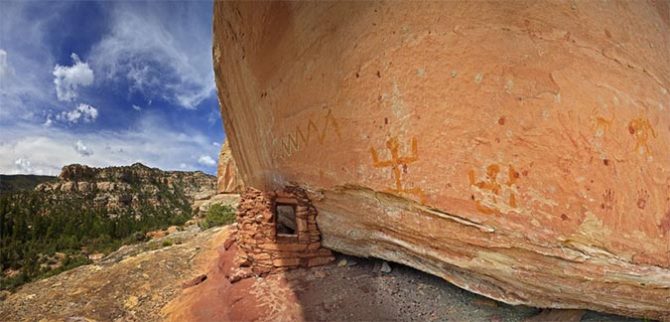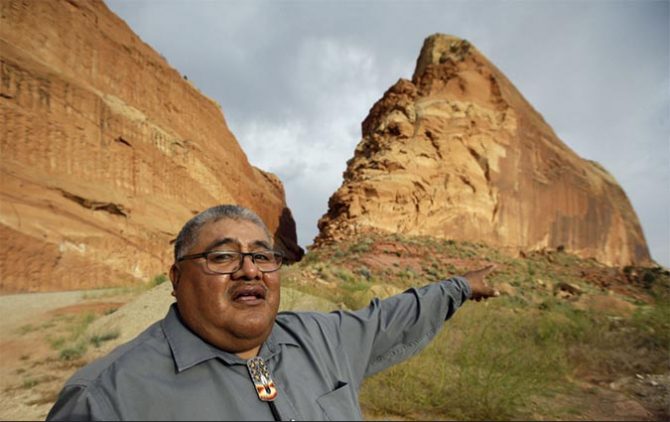
As one of his last acts as president, Barack Obama employed the mighty Antiquities Act to create Bears Ears National Monument in Southeastern Utah. The monument, which was requested by representatives of Native American tribes and a coalition of environmental groups, archeologists and recreation lovers, contains some of the most stunning scenery in Southern Utah and thousands upon thousands of fragile ruins and artifacts from the ancient ancestors of the southwestern tribes. It rivals Mesa Verde National Monument, across the border in Colorado, in terms of the richness and number of its archaeological treasures. (Plus, it’s a sick place to climb, hike, bike, backpack, ATV, and run rivers—the San Juan.)
Meanwhile, in Utah’s capital city, the biggest trade gathering in the outdoor recreation biz, organizers of the Outdoor Retailer Show (OR), which has been held in Salt Lake City for 20 years, got fed up with Utah lawmakers hostility toward the creation of Bears Ears and ongoing efforts bring all federal lands in Utah under their control and gave the Beehive State a stiff middle finger. The show is looking for a new home in other Western states.
OR brought in $45 Million annually and burnished the state’s brand as an outdoor recreation star, so it’s hard for all us outdoor types to understand why Utah’s political leaders would be so keen to kill the goose that lays the golden eggs. But let’s try. We asked the Southern Utah Wilderness Alliance’s Legal Director Steve Bloch to help us debunk the four myths that drive Utah’s conservative politicians’ rage against federal lands.
MYTH NO. 1: There’s gold (or whatever) in them thar’ hills.
There is a long-standing belief that if mineral and fossil fuel prospecting and exploration was unfettered, gushers of black gold (oil) would explode from the sage brush, rich veins of coal would be uncoiled and the lackluster economies of rural southern Utah would explode. Except. No. The BLM, which manages the federal land in Southern Utah, sells leases for mining and fossil fuel extraction and they ain’t selling many in San Jan County, the part of Utah that contains Bears Ears. “There’s this view in San Juan County that if they only had these 1.35 Million Acres (of the monument) there would be all these oil and gas and mining jobs,” Bloch says. “But they’ve never had them and that’s not because of the Federal Government, it’s because the resources aren’t there.” There is, however, uranium and, in fact, the monument designation deliberately excludes a promising site for uranium mining provided the uranium market returns. I guess we can cross our fingers that Trump starts a nuclear arms race? (Moab, which you might have heard of, was basically a busted down uranium and potash mining town before it became the, admittedly, overrun outdoors mecca it is today.)

MYTH NO. 2. Native Americans Don’t Want it.
Obama’s decision to create the monument was strongly influenced by an unprecedented unified petition from the five Native American tribes (Navajo, Hopi, Zuni, Ute Mountain Ute and Uintah Ouray Ute) in the region. These tribes are the descendants of the Ancestral Puebloans who left the thousands of cliff dwellings, as well as artifacts, all over the place down there. And they continue to use the area to practice living traditions such as medicinal herb gathering (another myth holds that these practices will be prohibited in the monument, not true). Further, the designation calls for the first ever representation of the tribes in the actual management of the monument. “There are Native Americans who are against it, sure,” Bloch says. “Just like not everyone in America supports the Trump Administration, but he is still president. You can’t take the opinions of a vocal few and say, ‘Native Americans are against the monument’ because it’s just not true.”
MYTH NO. 3 The State of Utah can manage federal lands better than Washington.
In addition to Utah’s asking for the rollback of the Bear Years Monument declaration, they are agitating to take control over all federal lands in Utah, arguing that local control is better. First, the move goes against the constitutions of both the United States and Utah, which as a condition of statehood way back in 1896 agreed to forsake all claim to federal lands within its borders.
Second, it’s a ruse to sell off the land to the highest bidders. Studies conducted, and let me all caps this BY THE STATE OF UTAH, show that maintaining all the lands in Utah currently held by the Feds, is fiscally impossible. Right now, the BLM and Forest Service nationwide, devote most of their dough to wild land firefighting and prevention and are running on funding fumes. Utah doesn’t want to pay that bill, so what it would have to do, Bloch says, is sell off the land to private interests for a one-time cash out. Recreationalists from hunters to rock climbers, anglers to river runners, ATV and dirt bike riders to backpackers who have enjoyed playing in these largely unrestricted public lands will face no trespassing signs, fees to play and worse under this scenario. “It doesn’t pencil out,” Bloch says, “You are going to need to generate revenue and one of the ways to generate revenue is exorbitant fees in the places you hunt, fish, climb and it’ll end up being really expensive and difficult to access.”

Outiftters working the Grand Staircase-Escalante National Monument Photo: Sierra Club
MYTH NO. 4 Monuments hurt rural economies.
Yes. If you mean the rural economy that doesn’t exist anymore. “People wish it was 1950, or even earlier. They wish that this was the frontier and extractive industry and grazing would be enough to save the day and it’s clearly not,” Bloch says. “They assign blame for that to someone else.” In this case, the faceless federal government. In fact, Garfield County and Kane County, where president Bill Clinton created the Grand Staircase-Escalante Monument in 1996, is growing with jobs related to the outdoors—guiding companies, outfitters, food and lodging companies. The Garfield Chamber of Commerce sent a crew up to Salt Lake City to plead with the legislators to stop their efforts at scaling back and undermining that monument. “They say that Grand Staircase pushed out grazers and made timber harvesting impossible but those industries were going downhill before the monument. (Plus, grazing is allowed by permit in the monument). People are being asked to adjust and that’s not necessarily what they want to do.”

